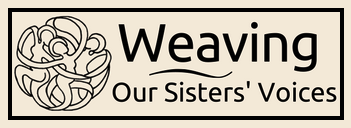Browse Exhibits (13 total)
The Initial Inspiration
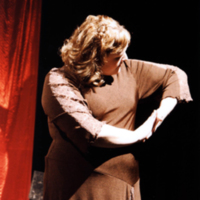
What if, my friends, it was into your hands my body was delivered that day?
The more I engage with Weaving Our Sisters’ Voices, the more depth and power I find it has. Weaving Our Sisters’ Voices is poetry, script, time machine, tool for empowerment, a way to give voice, and an opportunity to dialogue about yesterday and today. But to hand someone the script, or to say I want to put on a ‘show,’ minimizes the power these stories have.
This site is an attempt to capture all the facets that this simple selection of poetry has meant to the artists, students, and scholars who have had a chance to develop the work.
Constructing a Script, Medallions, and Midrash
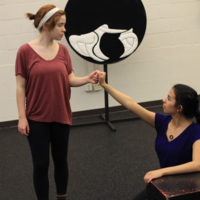
And me…what did I feel?I was angry.WSV Scene 4 – Righteous AngerJob’s Wife (Job 2:9-10)
The more I was aware of the silence forced upon women’s stories through history, the more I realized this was my call to action and to embrace the righteous anger it instilled in me.
Challenges: Voices of Women, Men, and Music, and Creating an Original Ensemble Work
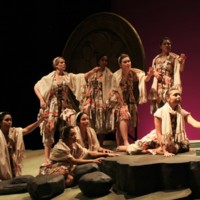
You knowChange never comes easilyBut voices—Our VoicesMade a difference
Directing any show presents its own challenges, and it takes courage to find artistic solutions to those challenges. The courage of the women in these stories served as an inspiration for my own challenges and opportunities. While the women from Weaving Our Sisters’ Voices faced hardships greater than my own, I still drew from their courage as I created, directed and choreographed these theatrical productions.
Student Impact: Performing, Embodying, and ASL
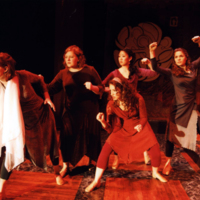
Women have powerThe power to be herosThe power to make a differenceAll of us matterIncluding you…WSV Scene 7 - I MatterRahab (Josh 2: 6:16-25)
Reiterations and Design: Costuming and Set
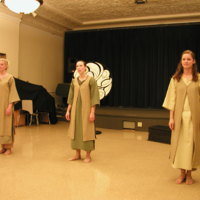
They were afraid that one woman --could act as a catalystThey were afraid that one woman --could challenge the status-quoAnd you know –they were right!Scene 8 - Not an ObjectVashti (Esth 1:9-19; 2:1; 4:17)
In a talk back after a performance, Dr. Linda Schearing explained that ‘scripture’ lives beyond a single point in time through its universally effective message. This is a living, breathing script; each reiteration brings new life from the visions of scenic and costume designers. Weaving Our Sisters’ Voices is meant to grow alongside the community engaging it, much like the Scripture it comes from.
Audience members found the design elements enriching. The sloping stage depicting sand and rocks set the scene. The rhythmic dances and movements and the accompanying music emphasized the weaving of the women’s stories. The beige fabric pieces that became scarves, head coverings, mats, baby wrappings, and covers, gave visual meaning to what was happening in the stories.
"The large circular object at center stage that was taken apart and reassembled by the players was a mosaic of how all the women’s trials and hardships, courage and faith formed an interwoven pattern. The story of the Levite’s concubine and the dismantling of the object was a stunning introduction to the presentation."
– Ellen Hargrove, audience member 2015
In the end, the collaborative process resulted in a unity of creative elements which helped tell the story. I was proud of the collaboration with my colleagues, and it is always a good education for my students to see how that process works.
Community Impact: Tour, Experiments, and Re-Staging
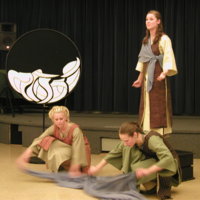
You deserve moreBecause you are worth more—you are worthy of loveWSV Scene 9 - Worthy of LoveThe Shulammite Woman (Song of Songs)
Weaving Our Sisters’ Voices is about helping us see the worth of ourselves, of our sisters, of stories of the past, and of our communities. From the beginning it was important to both Linda and I that the women of today who feel as though they have no voice have access to the performance.
Value is derived from producing Weaving Our Sisters’ Voices, embodying the stories, and gaining new perspectives on today. Many different audiences experienced this show from the very first tour to the university theatre audience.
In some ways it is easy to set aside these stories as from the past, or ‘just’ Scripture. Yet from audience reactions and responses, we were able to see this show as one of stories of today, Voices of Today. Sharing stories with each other is a powerful experience, but then also being able to connect our struggles and our triumphs to our ancestors gives us a sense of power and strength. If those women from long ago with challenges greater than ours could succeed in changing laws and standing up for themselves, then we can too. Knowing their stories can give us a deeper understanding of the greater impact of human nature and perhaps even a sense of hope for progress. These intimate touring performances really brought this to light.
Weaving Interdisciplinary Voices
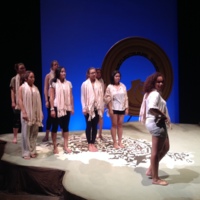
Theatre is inherently interdisciplinary. When I produce a piece of theatre I, as director and choreographer, collaborate with the design team that folds the visual arts elements through scenic and costume design into the overall vision (as covered in Reiterations and Design).
Weaving Our Sisters' Voices has interdisciplinary impacts with not only Theatre, Dance, Music and Visual Arts/Design, but also with Religious Studies, Women’s and Gender Studies, and History.
Even though these are stories from long ago, it is clear that the sharing of them gives power to those performing and those witnessing. The integrity of these stories empowers those that experience it and together the power is shared. If women from these ancient stories, whose challenges were greater than ours, persevered, then we can too. If women today are still facing issues that these women from ancient stories faced, we must persevere. These themes are prevalent in the field of Women and Gender Studies.
Take-Aways: Spirituality, Discussions, and Reflections
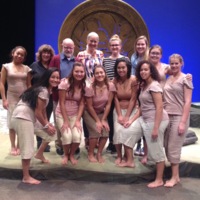
What’s a mother to doWhen children grow upAnd awayFar away from their mother’s protecting arms?
WSV Scene 12 – Nurturer+Caregiver+SisterhoodElizabeth, Mary, and Jochebed
The power of Weaving Our Sisters’ Voices is the integrity of the women it honors. We live this integrity by performing and watching WSV, but also through reflecting and discussing its content and experience. At Gonzaga, this is part of the Jesuit tradition, and we were blessed in the Theatre program to have our chaplain Father George Morris to guide the production's spiritual focus.
A major element of Weaving Our Sisters' Voices is the conversations that we hope the stories and performances illicit. Giving the audience a pause at the end of the performance for reflection, and then discussing the issues and questions that Weaving Our Sisters’ Voices raised is part of the entire experience.
While we provided expert professors from Women & Gender Studies, Religious Studies, or a professional theatre company for those conversations, what was particularly exciting in 2015 was the way the student artists engaged in the discussion. Audiences always want to hear from the performers, but the level of thought and perspective presented by these young artists was particularly inspiring.
Dramatis Personae
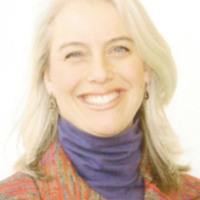
Click the links to the right to view cast information by each production of the show.
Katey Roden
Elise Kuterbach
- 2015 Performer
- Website Editorial Design Consultant
- Website Digital Design Architect
Janine Warrington
- 2015 Performer
- 2017 Show Director
- Website Thematic/Content Consultant
All Testimonials:
"In seeing the other side of these women’s stories, we get a fuller picture of grace, beauty, love, redemption, and wonder." - Mackenzie Draper, audience member
"This experience has allowed me to grow as an actor as well as an individual in ways I did not know possible." - Olivia Roberts, cast member
"I remember a lot of these women's stories echoing in the back of my mind and how most of those stories were very similar to the issues a lot of women face today." - Saeed al-Thumali, audience member
